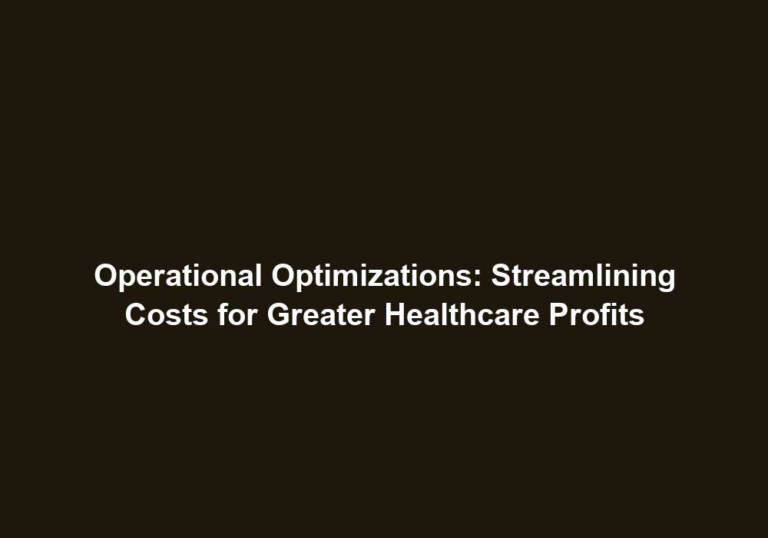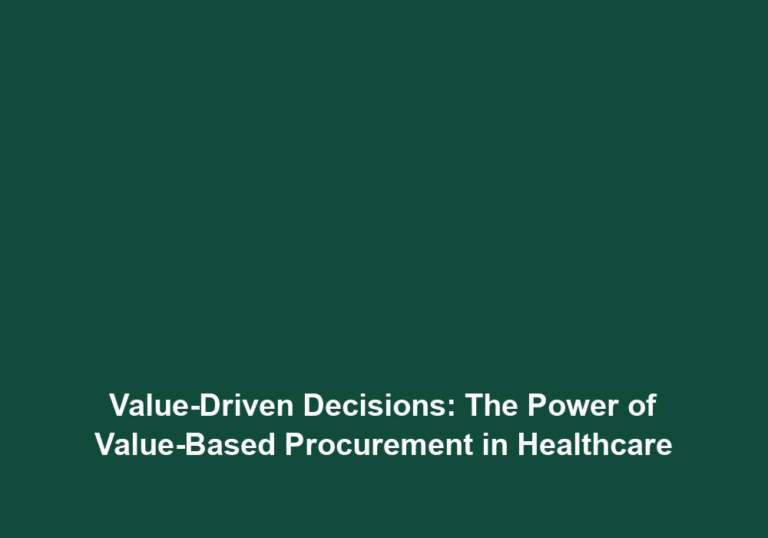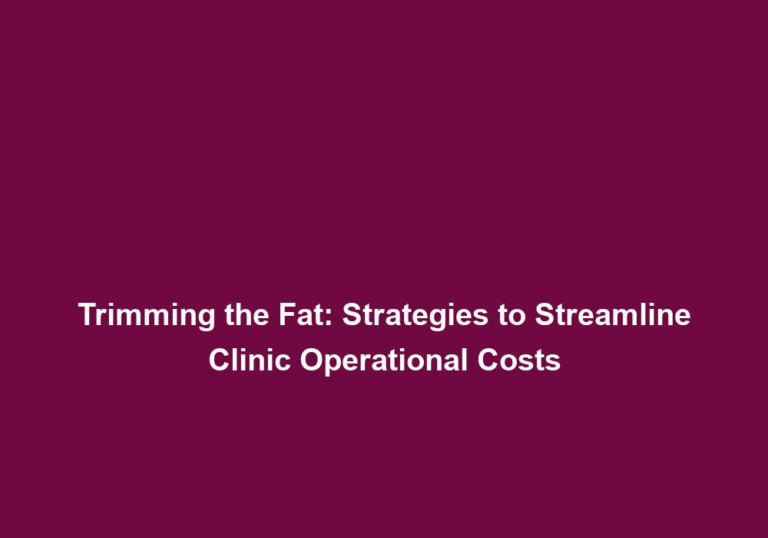From Cost to Value: Making Strategic Procurement Choices in Healthcare
In the rapidly evolving healthcare industry, strategic procurement choices play a vital role in achieving cost efficiency while ensuring the highest quality of patient care. Healthcare organizations are continuously seeking ways to optimize their procurement processes and transition from a focus solely on cost to a more value-driven approach. This shift allows healthcare providers to balance financial savings with the acquisition of innovative technologies, products, and services that can enhance patient outcomes and overall operational efficiency.
Understanding the Importance of Strategic Procurement in Healthcare
Efficient procurement practices in healthcare can lead to substantial cost savings, improved patient experiences, and better outcomes. By strategically selecting suppliers, negotiating favorable contracts, and implementing effective supply chain management strategies, healthcare organizations can streamline their operations and drive down costs.
Additionally, strategic procurement enables healthcare providers to evaluate the value proposition of different products and services. Value, in this context, refers to the overall benefits derived from a purchase, including quality, reliability, innovation, and long-term cost-effectiveness. By assessing the value of procurement choices, healthcare organizations can make informed decisions that promote better patient care while optimizing financial resources.
Key Factors in Strategic Procurement Decision-Making
- Quality and Reliability: When choosing suppliers and products, healthcare organizations must prioritize quality and reliability. This ensures that patients receive the best possible care and minimizes the risk of product failures or service disruptions. Selecting reputable suppliers with a proven track record of delivering high-quality products and services is crucial.
- Quality and reliability are vital in healthcare procurement as they directly impact patient care. Choosing suppliers with a strong reputation for quality ensures that healthcare organizations can provide the best care possible.
- Reliable suppliers help minimize the risk of product failures or service disruptions, which can have detrimental effects on patient outcomes and operational efficiency.
- Conducting thorough research and due diligence on suppliers’ quality control processes, certifications, and customer reviews can help healthcare organizations make informed decisions.
- Cost and Financial Impact: While cost should not be the sole determining factor, it remains an essential consideration for healthcare organizations. Balancing financial resources with the need for quality and innovation is crucial. Providers must evaluate the total cost of ownership, including not only the upfront purchase price but also ongoing maintenance, support, and potential future upgrades or replacements.
- Cost considerations are important to ensure financial sustainability for healthcare organizations. However, it is essential to strike a balance between cost and value.
- Evaluating the total cost of ownership allows healthcare organizations to understand the long-term financial impact of a procurement decision, including maintenance, support, and potential future expenses.
- Implementing cost-saving measures, such as bulk purchasing and negotiating favorable contracts, can help healthcare organizations optimize their financial resources without compromising quality.
- Compliance and Regulatory Requirements: Healthcare organizations operate under strict regulatory frameworks. Compliance with these requirements is paramount. When choosing suppliers, providers must ensure that they meet all necessary certifications and adhere to relevant regulations. Failure to comply can result in legal and financial consequences, as well as potential harm to patients.
- Compliance with regulatory requirements is critical for maintaining patient safety and avoiding legal and financial repercussions.
- Healthcare organizations must perform thorough due diligence on suppliers to ensure they meet all necessary certifications and comply with relevant regulations.
- Developing a robust supplier evaluation process that includes compliance checks and ongoing monitoring can help healthcare organizations mitigate risks and ensure adherence to regulatory requirements.
- Innovation and Technology: The healthcare industry is constantly evolving, with new technologies and innovations emerging regularly. Strategic procurement decisions should consider the potential for these advancements to improve patient care and operational efficiency. Investing in innovative products and services that align with the organization’s long-term goals can provide a competitive edge and position the organization as a leader in the industry.
- Embracing innovation and technology in procurement can lead to improved patient outcomes and operational efficiency.
- Healthcare organizations should stay informed about emerging technologies and assess their potential impact on patient care and organizational goals.
- Partnering with suppliers who are at the forefront of innovation can provide healthcare organizations with access to cutting-edge products and services that give them a competitive advantage.
- Supplier Relationships and Collaboration: Building strong relationships with suppliers is essential for successful procurement. Open communication, collaboration, and trust enable healthcare organizations to negotiate favorable contracts, access volume discounts, and receive superior customer service. Regular performance evaluations and feedback loops contribute to ongoing improvements and drive value creation.
- Strong supplier relationships foster collaboration, which can lead to mutually beneficial outcomes in procurement.
- Open communication and trust allow healthcare organizations to negotiate favorable contracts, ensuring cost savings and access to quality products and services.
- Regular performance evaluations of suppliers help healthcare organizations identify areas for improvement and maintain high standards of service and quality.
Best Practices for Strategic Procurement in Healthcare
To effectively transition from a cost-focused to a value-driven procurement approach, healthcare organizations should consider the following best practices:
- Develop and Implement a Procurement Strategy: A well-defined procurement strategy is critical for aligning procurement decisions with broader organizational goals. The strategy should outline objectives, key performance indicators, and guidelines for selecting suppliers, managing contracts, and evaluating value. Regularly reviewing and updating the strategy ensures its continued relevance in a dynamic healthcare landscape.
- A comprehensive procurement strategy provides a roadmap for healthcare organizations to achieve their procurement goals and objectives.
- The strategy should clearly define key performance indicators that measure the success of procurement initiatives, such as cost savings, supplier performance, and value creation.
- Regularly reviewing and updating the procurement strategy allows healthcare organizations to adapt to changing market conditions and emerging trends.
- Leverage Data and Analytics: Data-driven decision-making is essential in strategic procurement. By leveraging analytics tools and technologies, healthcare organizations can analyze spending patterns, identify cost-saving opportunities, and track supplier performance. An integrated procurement software system can streamline data management, facilitate transparency, and enhance decision-making processes.
- Data and analytics provide valuable insights into procurement patterns, supplier performance, and cost-saving opportunities.
- Healthcare organizations should invest in robust data management systems and analytics tools to effectively leverage data for decision-making.
- Implementing an integrated procurement software system enables healthcare organizations to streamline data management, enhance transparency, and make informed procurement decisions.
- Engage Stakeholders: Engaging stakeholders, including clinicians, administrators, and procurement staff, is crucial for successful procurement outcomes. Involving stakeholders in the decision-making process and soliciting their input fosters collaboration and buy-in, ultimately leading to more effective procurement choices. Regular communication channels should be established to ensure ongoing feedback and continuous improvement.
- Involving stakeholders in procurement decisions ensures that the needs and preferences of end-users are considered.
- Regular communication channels, such as meetings and feedback sessions, enable stakeholders to provide input and share their perspectives on procurement choices.
- Collaboration between stakeholders promotes a sense of ownership and accountability, leading to more successful procurement outcomes.
- Invest in Training and Skills Development: Effective procurement requires a skilled and knowledgeable workforce. Investing in training programs, certifications, and skills development initiatives for procurement professionals enhances their ability to make informed decisions, negotiate effectively, and manage supplier relationships. Continuous professional development ensures that procurement staff stay abreast of industry trends and best practices.
- Providing training and skills development opportunities ensures that procurement professionals have the necessary knowledge and expertise to make strategic procurement decisions.
- Certifications and ongoing professional development programs help procurement professionals stay updated on industry trends, regulatory changes, and best practices.
- Investing in the skills development of procurement staff contributes to the overall success of procurement initiatives and enhances the organization’s procurement capabilities.
- Monitor and Evaluate Performance: Regular monitoring and evaluation of procurement performance are essential for identifying areas of improvement and measuring the effectiveness of procurement strategies. Key performance indicators should be established to assess cost savings, supplier performance, compliance, and overall value creation. Continuous improvement initiatives should be implemented based on the insights gained from performance evaluations.
- Establishing key performance indicators enables healthcare organizations to measure the success of procurement initiatives and identify areas for improvement.
- Regular performance evaluations of suppliers and internal procurement processes help healthcare organizations identify inefficiencies and implement corrective measures.
- Continuous improvement initiatives based on performance evaluations ensure that procurement strategies and practices evolve to meet changing needs and objectives.
Conclusion
Transitioning from a cost-driven to a value-focused procurement approach is vital for healthcare organizations to thrive in today’s competitive landscape. By considering factors such as quality, cost, compliance, innovation, and supplier relationships, healthcare providers can make strategic procurement choices that optimize patient care, operational efficiency, and financial resources. Embracing best practices, leveraging data and analytics, engaging stakeholders, investing in skills development, and monitoring procurement performance contribute to achieving successful procurement outcomes in the healthcare industry.






